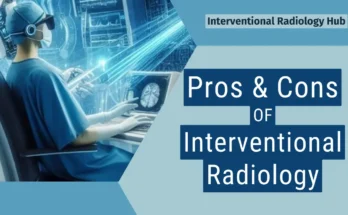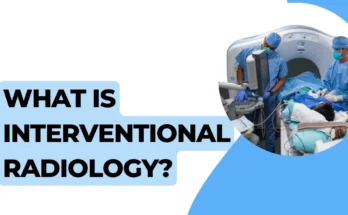
Table of Contents
Interventional radiology (IR) offers minimally invasive cancer treatments guided by imaging techniques. IR procedures can target tumors precisely, reducing damage to healthy tissue.Interventional radiology in cancer treatment has revolutionized cancer treatment by providing less invasive options with reduced recovery times. Radiologists use advanced imaging technologies such as MRI, CT scans, and ultrasound to direct instruments through small incisions, delivering treatments directly to the tumor site.
This precision allows for targeted therapies that can either destroy cancer cells or cut off their blood supply. Patients often benefit from lower risks and fewer complications compared to traditional surgery. IR techniques include ablation, which uses heat or cold to kill tumor cells, and embolization, which blocks blood vessels nourishing the tumor. These approaches are especially valuable for patients who cannot withstand conventional surgery, offering a potent alternative in the ongoing fight against cancer.
Diagnostic Techniques
Interventional radiology has transformed cancer diagnostics. These techniques let doctors see inside the body. They guide treatments. Key methods include image-guided biopsy and tumor staging. This ensures targeted cancer care. Let’s explore how.
Image-guided Biopsy Procedures
An image-guided biopsy is a key cancer diagnostic tool. It is less invasive. It is precise.
- CT Scans: They guide needle biopsies in the body.
- Ultrasound: Helps find lesions. Guides needles in real-time.
- MRI: Offers detailed images. Helps with soft tissue biopsies.
This method reduces complications. It improves accuracy. Patients recover fast.
Tumor Staging With Imaging Modalities
Tumor staging is crucial in cancer treatment. It maps cancer spread. Below are common tools:
| Modality | Use | Strength |
|---|---|---|
| PET/CT Scan | Locates metastasis | High sensitivity |
| MRI | Assesses soft tissues | Detailed imaging |
| Bone Scan | Finds bone involvement | Specific for bones |
These imaging modalities guide treatment plans. They monitor progress. They adapt treatment as needed.
Minimally Invasive Treatments
Interventional radiology has transformed cancer treatment. Patients witness fewer scars, less pain, and quicker recovery times. These treatments target tumors directly, protecting healthy tissue. Let’s explore some key procedures.
Radiofrequency Ablation
Radiofrequency Ablation (RFA) uses heat to destroy cancer cells. A specialist inserts a thin needle into the tumor. The needle sends out radio waves that heat and kill cells.
- Less discomfort compared to open surgery
- Quick return to daily activities
- Targeted approach with minimal side effects
Cryoablation
Cryoablation is a cold-based therapy. It freezes the cancer cells to death. A specialist uses imaging guidance to place a cryoprobe. Extreme cold is then applied. Benefits include:
- Effective for several cancer types
- Controlled cell destruction minimizes damage
- Outpatient procedure; no hospital stay needed
Chemoembolization
Chemoembolization delivers chemotherapy directly to the tumor. This blocks the tumor’s blood supply. Surrounding areas remain unharmed. It combines two cancer-fighting techniques for greater impact. Advantages include:
| Advantage | Details |
|---|---|
| High Drug Concentration | Direct tumor targeting enables higher doses |
| Reduced Systemic Effects | Healthy parts of the body are shielded from drugs |
| Slows Tumor Growth | Blocks nutrients and oxygen, hindering growth |
Pain Management
Interventional Radiology (IR) plays a key role in managing cancer-related pain. This innovative field uses minimally invasive techniques to relieve pain and improve the quality of life for patients. These procedures are typically less painful, have fewer side effects, and offer quicker recovery times in comparison to traditional surgeries.
Neurolytic Blocks
Neurolytic blocks target nerves that send pain signals to the brain. By applying substances like alcohol or phenol, these nerves are temporarily blocked. IR specialists often use imaging techniques to place the needles accurately. This ensures the treatment impacts only the targeted areas.
- High precision in targeting pain nerves
- Quick relief for conditions like pancreatic cancer pain
Vertebroplasty And Kyphoplasty
Vertebroplasty and kyphoplasty stabilize broken bones in the spine. The pain from these fractures can be intense and debilitating. During vertebroplasty, doctors inject a special cement into the bone. Kyphoplasty includes an additional step where a balloon is used to expand the space for the cement. These procedures provide both pain relief and improved mobility.
| Procedure | Objective | Benefits |
|---|---|---|
| Vertebroplasty | Bone stabilization | Immediate pain relief |
| Kyphoplasty | Bone expansion & stabilization | Restoration of mobility |
Vascular Interventions
In the fight against cancer, Interventional Radiology (IR) stands out. IR offers minimally invasive procedures that use imaging guidance to specifically target tumors. Among these procedures, vascular interventions play a pivotal role. They help in both diagnostic and therapeutic ways. Let’s delve into two critical vascular interventions: angioplasty, stenting, and embolization therapy.
Angioplasty And Stenting
Angioplasty is a procedure to open narrowed or blocked blood vessels that supply blood to tumors. It uses a balloon that inflates inside the vessel. Stents are tubes placed in the vessel to keep it open.
- Restores blood flow to the affected area
- Improves delivery of chemotherapy to the tumor
- Minimizes risks and recovery time compared to open surgery
Stenting often follows angioplasty. It enables continuous blood flow. It helps reduce the tumor’s supply of nutrients, affecting its growth.
Embolization Therapy
Embolization therapy targets the blood vessels feeding the tumor directly. Tiny particles, known as embolic agents, are delivered to block these vessels.
| Type of Embolization | Purpose |
|---|---|
| Chemoembolization | Delivers chemotherapy straight to the tumor |
| Radioembolization | Combines embolization with radiation therapy |
This approach minimizes systemic exposure and side effects. It focuses on reducing tumor size and alleviating symptoms, thereby improving life quality.
Emerging Technologies
Nanotechnology In Cancer Therapy
Nanotechnology in cancer therapy leverages tiny particles for big results in cancer care. Nanoparticles, tinier than cells, deliver drugs directly to cancer cells. This precision spares healthy cells and minimizes side effects. Nano-sized carriers, like liposomes and micelles, safely transport chemotherapy agents. They reach tumors more effectively than conventional methods.
- Targeted drug delivery enhances treatment efficacy
- Minimized damage to healthy tissues
- Improved drug solubility and circulation time
Thermal Ablative Techniques
Thermal ablative techniques involve heating or cooling tissue to kill cancer cells. These methods are remarkable due to their minimal invasiveness. Infrared rays or lasers heat the tissue in procedures like Radiofrequency Ablation (RFA). Cold treatments such as Cryoablation freeze the cancer cells. Thermal therapies have various benefits:
| Technique | Description | Benefits |
|---|---|---|
| RFA | Uses radio waves to heat tumors | Quick recovery, highly precise |
| Cryoablation | Destroys cancer by freezing | Less pain, minimal scarring |
| Microwave Ablation | Heats cancer cells with microwaves | Effectively treats larger areas |
These innovative interventional radiology methods are redefining cancer care. Embracing these technologies, medical professionals tailor treatments to individual patient needs. As a result, outcomes improve, and patient quality of life is preserved.
Clinical Outcomes
Survival Rates
One major yardstick to measure cancer treatment success is survival rates. Patients want to know, “How long can I live with this treatment?” Studies highlight that IR treatments, like radiofrequency ablation and chemoembolization, are often associated with extended survival times in certain cancers.
- Liver cancer patients see improved survival rates with IR methods.
- Lung and kidney cancer treatments with IR also show promising results.
It’s important to view survival rates with the type and stage of cancer in mind.
Quality Of Life Improvements
Beyond extending life, how well patients live matters. IR aims to reduce pain and increase mobility.
| Treatment | Quality of Life Benefit |
|---|---|
| Tumor Embolization | Less pain, fewer symptoms |
| Vertebroplasty | Improved mobility, reduced spinal pain |
Each IR procedure brings a potential increase in comfortable living days. This is critical for patient morale.
Comparative Studies
Looking at comparative studies gives us a clearer image of IR’s impact.
- IR versus traditional surgery.
- IR versus systemic therapies.
Targeted IR therapies often result in less postoperative recovery time and fewer complications. Such studies affirm that IR stands on par or even excels in certain aspects. This spans across a variety of cancers.
Future Directions
As medical science progresses, the field of interventional radiology (IR) continually evolves. The future of interventional radiology in cancer treatment promises even more precise and personalized treatment options. The advancements aim to minimize invasiveness while maximizing therapeutic outcomes. Let’s explore some groundbreaking developments on the horizon.
Advancements In Image-guided Therapies
The continuous improvement of imaging technology proves vital for cancer treatment. Image-guided therapies rely on detailed visualizations of tumors to deliver precise treatment. The evolution of these advanced imaging techniques has the potential not only to enhance the accuracy of interventional procedures but also to reduce patient recovery time and increase the rate of successful treatments.
- Real-time imaging guidance allows for immediate adjustments during procedures.
- Nanoparticle-enhanced imaging could provide clearer pictures of tumor margins.
- Robotics integration is poised to offer higher precision in navigating complex anatomical structures.
Personalized Medicine Approaches
Personalized medicine is reshaping oncology treatment plans. By tailoring therapy to the individual genetic makeup of both patient and tumor, IR can deliver targeted, efficient interventions. This reduces side effects and enhances efficacy.
| Technology | Benefits |
|---|---|
| Genetic profiling | Enables selection of optimal therapeutic strategies. |
| Biomarker targeting | Improves precision of tumor ablation and drug delivery. |
| Immune system modulation | Increases the body’s ability to fight cancer. |
Future interventional radiology is heading towards combining real-time data and machine learning algorithms to predict treatment outcomes. This will allow doctors to customize treatments further and adjust them on-the-fly, promising enhanced survival rates and quality of life for cancer patients.
Conclusion
Embracing interventional radiology offers a beacon of hope in the relentless battle against cancer. Its precision and minimally invasive approach usher in a new era of cancer care. This innovation underlines our commitment to advancing treatment, enhancing recovery, and improving patient outcomes.
As we forge ahead, interventional radiology stands as a pivotal ally in our journey towards conquering cancer.
Commonly Asked Questions about "Interventional Radiology in Cancer Treatment"
- Interventional radiology plays a crucial role in cancer treatment by offering minimally invasive procedures that target tumors directly, leading to effective tumor destruction or reduction.
- Interventional radiology techniques can be used to treat various types of cancer, including liver cancer, lung cancer, kidney cancer, prostate cancer, and bone cancer, among others.
- The benefits of interventional radiology in cancer treatment include reduced trauma to surrounding healthy tissues, shorter recovery times, lower risk of complications, and improved quality of life for patients.
- The risks and side effects associated with interventional radiology procedures for cancer treatment may include bleeding, infection, damage to nearby organs or tissues, and allergic reactions to contrast agents used in imaging.
- The risks and side effects associated with interventional radiology procedures for cancer treatment may include bleeding, infection, damage to nearby organs or tissues, and allergic reactions to contrast agents used in imaging.
- Common interventional radiology procedures used in cancer treatment include radiofrequency ablation, microwave ablation, cryoablation, chemoembolization, radioembolization, and percutaneous tumor biopsy.
- Yes, interventional radiology can be used in combination with other cancer treatments such as chemotherapy, radiation therapy, and surgery to provide comprehensive care tailored to the patient’s individual needs.
- Factors that determine if a patient is a candidate for interventional radiology for cancer treatment include the type and stage of cancer, the location and size of the tumor, the patient’s overall health and medical history, and their preferences for treatment.
- Recovery times from interventional radiology procedures for cancer vary depending on the specific procedure performed, the patient’s overall health, and the location and size of the tumor. In general, patients can expect shorter recovery times compared to traditional surgery.
- The long-term effects of interventional radiology treatment on cancer patients may include tumor recurrence, changes in organ function or structure, and potential complications related to the procedure. Regular follow-up appointments with healthcare providers are important for monitoring the patient’s progress and addressing any concerns.




